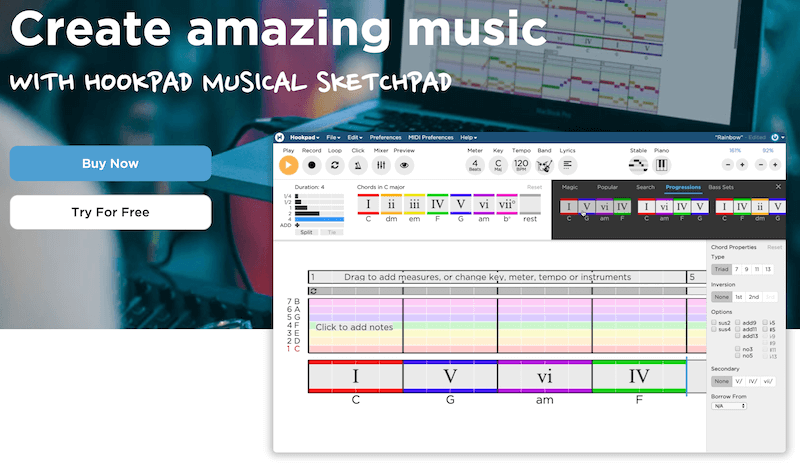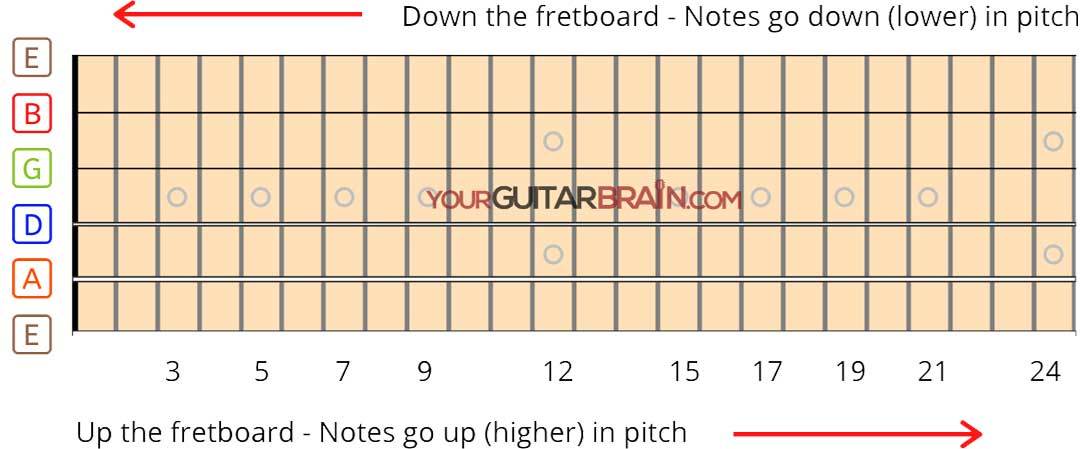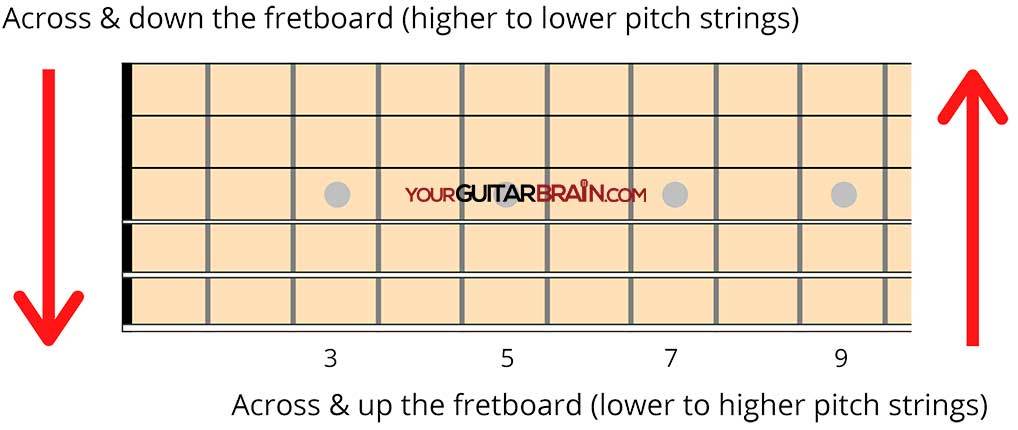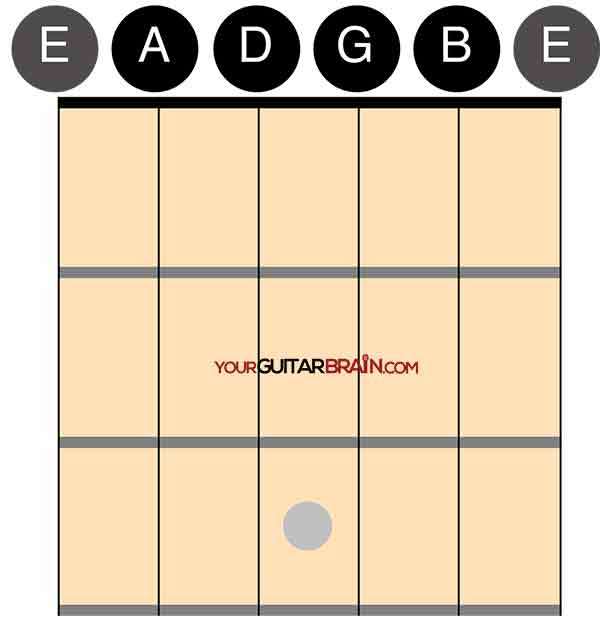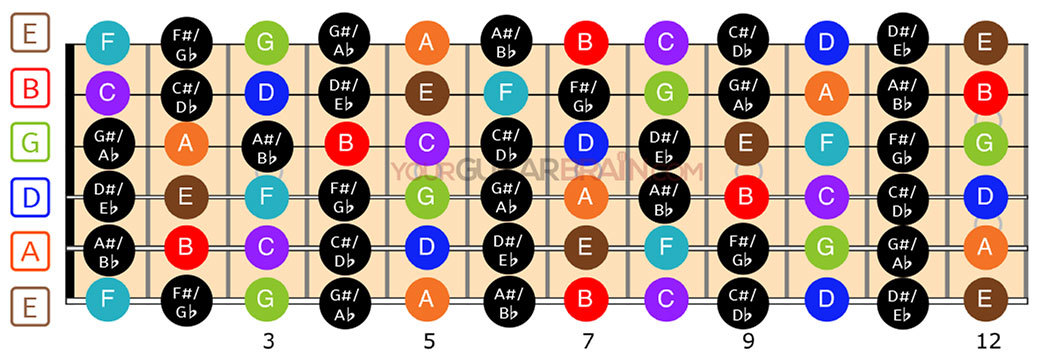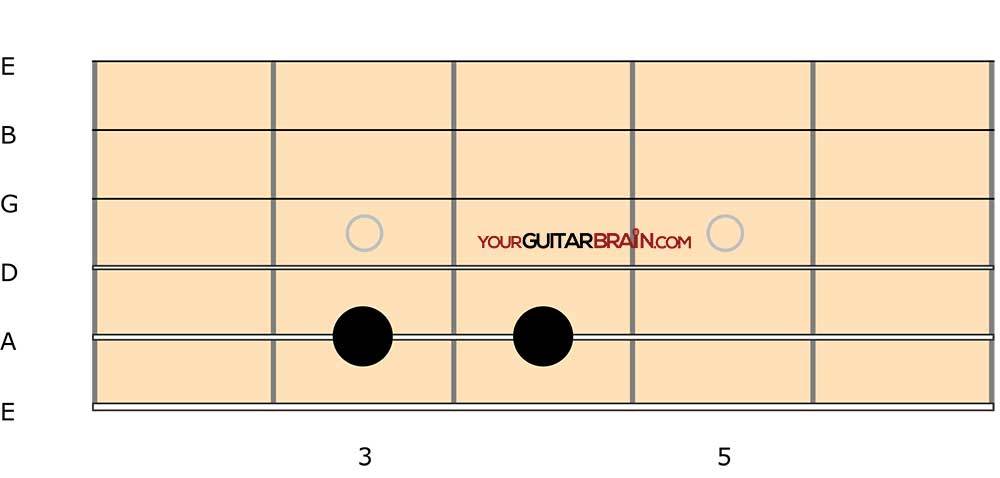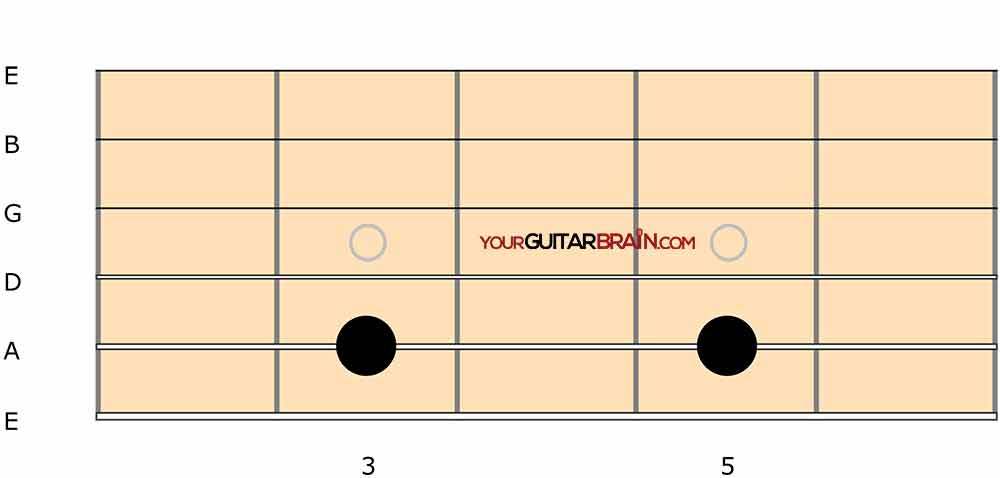Guitar fretboard mastery: The best and fastest way to learn the notes on the guitar. Beginner-friendly tips to help you move lightning-fast around the guitar neck and sound deliciously epic.
- Excerpt from the Book ‘Easy Peasy Guitar Music Theory
- Further Reading – Free guitar fretboard notes diagram (12 frets and 24 frets)
Do you want to learn the guitar fretboard quickly and easily?
If so, read on! This post will teach you the 5-Step Memory Method, a well-tested approach to help you remember the guitar neck notes and smoothly move around the fretboard.
Whether you’re a beginner or an experienced player, this method can help you take your guitar playing to the next level.
Table of Contents
5 Reasons Why You Need to Learn the Fretboard Notes
Learning the fretboard notes is super important for guitarists because it helps you:
1. Play Chords Anywhere:
- When you can pinpoint the fretboard notes, you can find and play chords all over the guitar neck without trouble.
- It lets you try different ways to play chords to make your playing sound more exciting.
2. Rock Your Solos:
- It makes it easier to move around when you’re playing solos or making up tunes on the spot.
- You can create your own awesome guitar solos that really impress your friends.
3. Switch Chords Faster:
- You can switch between chords and notes more quickly, making your playing smoother.
- You won’t need to rely on chord charts as much, making your live performances more exciting.
4. Play Faster and Better:
- It speeds up your playing because you won’t have to pause to find the right spots on the neck.
- Your guitar playing will sound better and more accurate.
5. Be a Musical Explorer:
- Knowing the notes the fretboard opens up all sorts of musical styles and songs for you to try.
- You’ll be ready to play in any situation, whether it’s a casual jam with friends or recording in a studio.
The 5-Step Memory Method is a powerful way to memorise the notes on the guitar fretboard.
The method is based on the principles of spaced repetition and memory aids (mnemonics), which are both scientifically proven to be effective learning techniques.
Let’s get started, and I’ll explain it all in a step-by-step way.
NO FALSE PROMISES!
If you want to become skilled at playing the guitar, it's important to set realistic goals and practice regularly. Don't think you'll conquer the fretboard in a mere couple of days (despite some silly claims online). Slow and steady wins every time.
5 Steps to Learn the Fretboard
Crack the code of the guitar fretboard with these 5 easy steps. Ideal for beginners and if you’re seeking a quick refresh. Let’s make learning the guitar fretboard quick, easy, and rewarding!
Step #1. Know Your Ups and Downs
Let’s jump in with learning some of the beginner basics that’ll help you learn the notes on the fretboard.
When talking about directions on the guitar neck, it’s not uncommon for players to confuse their ‘ups’ and ‘downs’.
This is because the way we talk about directions on the guitar neck doesn’t always make sense to a beginner.
It boils down to this:
When you think in terms of pitch and fret numbers, rather than direction, it does make sense.
Stick with me here, and you’ll soon understand.
Take a look at the diagram below that shows the correct way to describe fretboard movement:
Fig 1.0 – Guitar fretboard diagram showing up and down directions
I’ll walk you through the easiest way to remember your directions on the guitar using two memorisation triggers:
1. Pitch
When your hand moves left down the neck towards the nut, the notes go down in pitch.
Therefore, we say we are “moving down” the fretboard when we go in this direction.
Conversely, when you move up the neck towards the guitar body, the pitch goes up – so we say we are “moving up” the fretboard when moving in this direction.
2. Fret Numbers
You count up from fret 1 to 2, to 3 and so on as you climb up the fretboard away from the nut. You guessed it – the same logic applies when you count down the frets in the opposite direction.
Another common slip-up guitar players make is getting confused over the proper terminology to use when talking about moving across the strings on the fretboard.
When moving across the fretboard from the thin top (1st) E string to the low (6th) E string, we say we’re moving across and down the fretboard.
Think of moving in the direction of the pitch again. By the same wisdom, you’re moving across and up the neck when you reverse direction and go from the low 6th string to the top 5th string.
Take a look at the diagram:
Fig 1.1 – Guitar fretboard diagram showing the right terminology when moving across the guitar neck
➡ See the action exercises at the end
Step #2. Open Notes
If you want to learn the notes on the fretboard, you can bet your bottom dollar you’ll find it hard work if you don’t know the open string note names.
Forgive me if this seems stupidly obvious, but you’d be surprised at the number of guitar students I’ve taught over the years who have skipped this step.
And I’m not just talking newbies, either.
In case you didn’t know, from the low E string (6th) to the top E string (1st), the guitar is tuned to these open notes:
E – A – D – G – B -E
Let’s take a peek at the notes in a fretboard chord box diagram:
Fig 1.2 – Standard open tuning on a six-string guitar
Pro Tip
Use the mnemonic Eat And Drink Good Boys Every day to help you remember the open guitar string notes running from the low 6th string to the top 1st string.
Once you commit the open string notes to memory, you’ve also learned the notes on fret 12 of the guitar neck as they’re the same. We call this an octave.
This is one reason your guitar has two fret markers at fret 12; they’re there to highlight that you’ve reached the octave. All of the notes past the 12 fret follow the same pattern as the first 12 frets.
Take a look-see.
Fig 1.3 – Fretboard diagram showing the notes on the 12th fret are identical to the open string notes
Pro Tip
The top and bottom strings are tuned to the same note of E. So, once you've memorised the notes on the low E string, you've automatically memorised the top E string notes. Sorted!
Step # 3. ABCs of Music
The ‘musical alphabet’ has 12 notes. The first seven notes go from A to G and are collectively called natural notes.
The five remaining notes are sharp (#) and flat (♭) notes, which occur between certain natural notes.
Also called accidentals, these notes raise (#) or lower (♭) a note by a semitone (half-step), as seen in the diagram below:
Fig 1.4 – Musical alphabet: 5 natural notes and 7 sharp/flat notes
Step #4. The Musical Ladder
When you play any string on the guitar from the open note and continue all the way up to where your finger touches the 12th metal strip, something interesting happens.
It’s like climbing a ladder in music, where each step is a different musical note. We call this ladder of notes the ‘chromatic scale.’
The chromatic scale notes follow the pattern of the musical alphabet. Starting on the C note, it looks like this:
C – C#/Db – D – D#/Eb – E – F – F#/Gb – G – G#/Ab – A – A#/Bb – B – C
The important thing to know that’ll help you find any note you fancy on the fretboard is the note pattern repeats all over the neck.
For instance, if you start on the D note on fret 5 of the A string, then play the note two frets up, in accordance with the chromatic scale, that would be an E note.
Take a look at the fretboard in all its glory here:
Fig 1.5 – Notes on the guitar fretboard diagram over 12 frets. Natural notes and sharp/flat notes are shown.
Have a go. Play any fret on the low E string and test yourself. Pick a random fret on the same string and see if you can determine the note.
Once you’ve read tip number 5 coming up, you’ll see it’s just a matter of layering the bits of knowledge we’ve covered so far and practice.
Step #5. Mind The Gaps
Here are some quick-fire facts about intervals on a guitar you need to get familiar with:
- An interval on a guitar is simply the distance between two notes.
- The distance between one fret to the next is called an interval of 1 semitone (See diagram 1.6)
- The distance between two frets is an interval of 1 tone (diagram 1.7).
Fig 1.6 – Interval of 1 semitone on the guitar fretboard
Fig 1.7 – Interval of 1 tone on the guitar fretboard
Most of the natural notes on your guitar fretboard are spaced one tone apart except for two pairs of notes.
These two pairs of notes are an interval of 1 semitone apart. Subsequently, they have no sharp or flat notes between them.
Let’s take a look:
A-B = 1 tone
B-C = 1 semitone
C-D = 1 tone
E-F = 1 semitone
D-E = 1 tone
F-G = 1 tone
G-A = 1 tone
That being the case, work on memorising that notes B-C are one semitone apart no matter where they are played on the fretboard.
The same applies to notes E-F. Consequently, there is no E# or F♭, B# or C♭ note on the guitar neck because they are right next to each other one semitone apart.
All of the remaining natural notes (A, C, D, F, A) are separated by an accidental sharp/flat note.
➡️ Best Guitar Lessons & Online Music Courses
Discover the best online guitar tutorial apps and music courses for beginners upwards to fast-track your musical gains!
JamPlay Check it out >>
TrueFire Check it out >>
Pickup Music Check it out >>
Coursera Check it out >>
7 Exercises to Help You Learn the Fretboard Notes Fast
Exercise 1: Getting the Right Directions
- Practice saying the fretboard directions out loud for a few minutes at the beginning of each practice session.
- E.g. Start with 6 x 30-second intervals of understanding and visualising fretboard movement directions, alternating between moving “up” and “down” the fretboard.
Exercise 2: Know Your Open Strings
- Play each open string and say the note name out loud x 10 at the start of each session.
- Challenge yourself with a quick quiz, naming random pen string note names.
Exercise 3: Master the Musical Alphabet
- Spend 5 minutes at the start of each practice session reciting the musical alphabet and its natural and sharp/flat notes.
- To reinforce your memory, engage in a 10-minute session once a week dedicated solely to this exercise.
Exercise 4: Explore the Chromatic Scale
- Allocate 10 minutes at the end of your practice session to play the variations of the chromatic scale.
- Use a metronome and gradually increase the speed.
Exercise 5: Understand Intervals
- Practice identifying intervals by naming notes on the fretboard, especially focusing on recognising one-semitone and one-tone intervals.
- Use a metronome to set a rhythm while naming intervals, starting at a slower tempo and gradually increasing it.
Exercise 6: Apply the Knowledge
- Spend at least 15 minutes during each practice session playing and experimenting with chords all over the fretboard.
- Challenge yourself to explore various chord voicings for 10 minutes, making your playing more versatile.
- Use a metronome to practice chord transitions, gradually increasing the tempo to improve your speed.
Exercise 7: Play Melodies and Solos (More Advanced)
- Dedicate 20 minutes in each practice session to playing melodies and solos while moving around the fretboard.
- Utilize your knowledge of notes and intervals to create expressive guitar solos.
- Experiment with different tempos and rhythms using a metronome to enhance your timing and versatility.
By incorporating these additional steps and variables, you’ll not only reinforce your understanding of the fretboard but also improve your overall guitar skills, including timing and speed.
Summing It Up
So there it is. Getting to grips with the notes on the fretboard doesn’t need to be daunting.
It’s a simple matter of memorising patterns and breaking them down into bite-size chunks. You have to take a step-by-step approach and break it down.
Start by memorising the tips in this article and applying them to your guitar practice routine for the following week.
This will help you form long-term memorisation and empower you to move on to step 2 of the 5-Step Memory Method.



